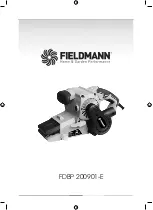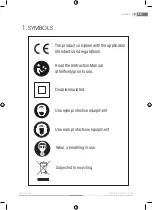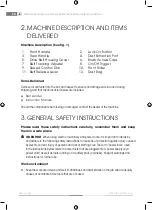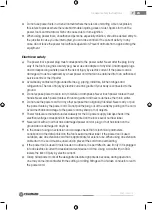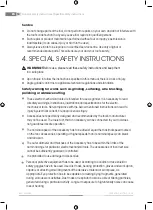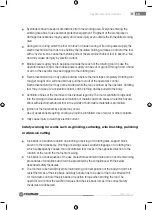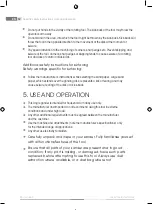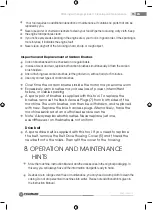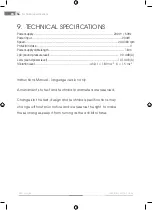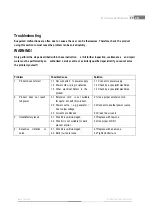
Specific safety instructions
FDB
P
2009
0
1-E
Bystanders have to keep a safe distance from the working area. Everyone entering the
working area has to use personal protective equipment. Fragment of the work piece or
damaged accessories may fly away and cause injury even outside the immediate working
area.
During work, during which the tool can touch a hidden wiring or its own power supply, the
electromechanical tool has to be held by the insulated holding surfaces. Contact of the tool
with a "live" wire can cause the metallic parts of the electromechanical tool to become "live"
and may cause an injury by electric current.
Mobile power supply has to be placed outside the reach of the rotating tool. In case the
operator looses control, the mobile power supply can be cut or ground through, and a hand
or arm of the operator may be dragged to the rotating tool.
Electromechanical tool may not be put down before the tool stops completely. Rotating tool
may get caught on a surface and may pull the tool out of the operator's control.
Electromechanical tool may not be started while the tool is carried by the operator. Rotating
tool may, in case of a accidental contact, catch clothing and be pulled to the body.
Ventilation holes of the tool have to the cleaned regularly. The motor ventilator brags dust
into the casing and excessive accumulation of metallic dust can cause an electric hazard.
Work with electromechanical tool in the vicinity of flammable materials is prohibited.
Ignition of the materials by sparks may occur.
Use of accessories requiring cooling by liquid is prohibited. Use of water or other coolants
may cause injury or death by electric current.
Safety warning for works such as grinding, surfacing, wire brushing, polishing
or abrasive cutting
Kick-back is a sudden reaction on pinching or seizing of a rotating disk, support block,
brush or other accessory. Pinching or seizing causes sudden stoppage of a rotating tool,
which subsequently causes, that uncontrolled tool moves in the opposite direction to the
rotation of the tool in the moment of seizing.
Kick-back is a consequence of the use of electromechanical tools and/or incorrect working
procedures of conditions and it can be prevented by the compliance with the below
described safety measures.
The tool has to be held firmly while maintaining a correct position of the body and arms to
resist the forces of the kick-back. Auxiliary handle has to be used if the tool is fitted with it,
for maximum control of the kick-back or reaction torque when starting the tool. The
operator can control the reaction torques and the kick-back forces if the correct safety
measures are observed.
1
1
EN
Summary of Contents for FDBP 200901-E
Page 1: ...FDBP 200901 E...
Page 2: ...3 A...

